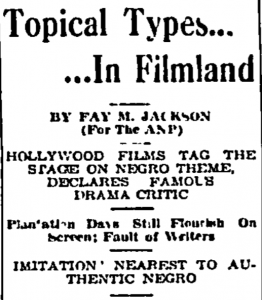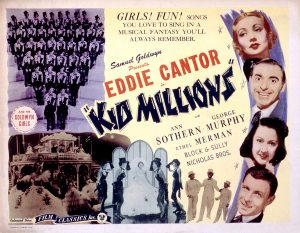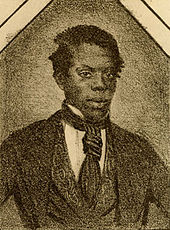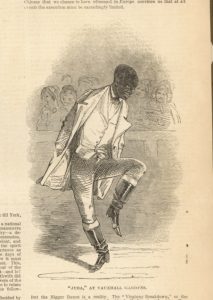In doing research about tap dancing in film, I can across a little article titled “Topical Types… in Filmland”, which appeared on page four of The Plaindealer on May 24, 1935.1 Although initially attracted by the mention of the Nicholas Brothers and Bill Robinson, the article’s subheadings kept me hooked:

Title and subheadings from article in The Plaindealer (Kansas City, Kansas), 1935.
Not only did it connect to the question of authenticity, which is another theme we’ve heavily discussed in class, but it also connected to another article I had recently read about Bill ‘Bojangles’ Robinson and the persistence of stereotyping roles in Hollywood film.
Jackson, a correspondent for the Associated Negro Press Hollywood begins by remarking about how “Negro film critics and fans” are often deemed too “squeamish” to discuss “what is and what is not an authentic portrayal of the Negro”, specifically in Hollywood film. So, Jackson states that she has decided to conduct a “symposium” with well-known white critics instead. In this article, she recounts her conversation with W. E. Oliver who was the Los Angeles Herald Express’s dramatic editor and screen reviewer.
Throughout the interview, Oliver makes several interesting claims about the silver screen’s portrayal of black people, but the most interesting of Oliver’s insights come in the form of the examples he draws upon. Oliver praises the Nicholas Brothers’ performances with Eddie Cantor in “Kid Millions”. This illustrates his claim that the trend in Hollywood seems to be using black performers as talent rather than “type”. An advertisement for the movie in the New York times in 1934 makes no mention of the brothers, even in its cast list.2 In fact, the Nicholas Brothers really don’t play roles in the plot line, they really only serve as dancers in one scene.

Poster for the film “Kid Millions” mentioning the Nicholas Brothers and depicting them with Eddie Cantor in blackface.
Additionally, especially from a modern standpoint, the content of their performance is very problematic. The scene that the brother appear in is the scene where the characters are putting on a minstrel show for the entertainment of the passengers on a cruise. Opening the scene is Harold, the younger of the brothers, sings “Minstrel Night”, which begins with the phrase “I want to be a minstrel man”. Furthermore, when both brothers dance, it is only with Cantor in blackface, which is interesting and problematic because this is essentially the only time when the brothers interact with any of the main characters on screen.3
But the Nicholas Brothers are praised for their work in the film which “brought them to the fore in that picture”. This was their first screen appearance and their exceptional dancing got them noticed. During the song “Mandy”, they effectively tap circles around Cantor and the other film stars who can’t seem to execute the steps together or in time. Ultimately, the scene seems to demonstrate that while Cantor may be able to appropriate blackness by putting on his face paint, he cannot match “black artistry”.4
The second example that Oliver provides is Bill Robinson’s performance in the “Little Colonel”. This is “one of the latest films featuring a Negro character” and it provides an example of the black “type” characters. Robinson plays a butler in the romanticized post-Civil War south and fulfills the archetypal role as a sort of “other” adult for the young Shirley Temple’s character.5
Although the type-character is bemoaned, Robinson’s performance itself is praised. Jackson writes that “his dancing made up for whatever lacks on may find with his characterization”. Notably, this is the film in which Robinson performs one of his most famous stair dances, effortlessly leaping up and down a flight of stairs while tapping.
Again, while the actual role and subject matter may be troublesome, the actual performance of tap is regarded as a redeeming factor. In this way, the black dancers demonstrate agency even within the confines of their roles. Hollywood may be trying to keep them in their place, but they are tap dancing on the boundary.
1Jackson, Fay M. “Topical Types… in Filmland”. Plaindealer (Kansas City, KS), May 24, 1935.
2 Sennwald, Andre. “‘Kid Millions,’ Mr. Goldwyn’s New Screen Comedy, With Eddie Cantor, at the Rivoli.” New York Times, Nov. 12, 1934.
3 Hill, Constance Valis. Brotherhood in Rhythm: The Jazz Tap Dancing of the Nicholas Brothers. New York: University Press, 2000. 86-87.
4 Ibid, pg 90-91.
5 Vered, Karen Orr. “White and Black in Black and White: Management of Race and Sexuality in the Coupling of Child-Star Shirley Temple and Bill Robinson.” The Velvet Light Trap – A Critical Journal of Film and Television (Spring, 1997): 52-65.


